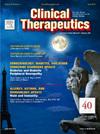一项开放标签、单剂量研究,评估奥尔帕西兰在血清脂蛋白升高的中国参与者中的药代动力学、药效学、安全性和耐受性。
IF 3.6
4区 医学
Q2 PHARMACOLOGY & PHARMACY
引用次数: 0
摘要
导读:心血管疾病(CVD)仍然是全球过早死亡和残疾的主要原因,中国是心血管疾病死亡人数最多的国家之一。脂蛋白(a) (Lp(a))是一种循环脂蛋白颗粒,当升高时,可能增加心血管疾病的风险。现有心血管治疗降低Lp(a)水平是适度的,并且缺乏证据证实降低Lp(a)是否会导致心血管获益。Olpasiran (AMG 890)是一种靶向肝细胞的小干扰RNA,已被证明可引起Lp(a)的显著降低,并具有可接受的安全性,目前正在世界各地的临床试验中进行评估。因此,研究奥帕西兰在中国人群中降低心血管风险的治疗潜力是很重要的。参与者和方法:这是一项1期、开放标签、随机、单剂量、平行组研究,在血清Lp(a)升高的中国参与者中进行。血清Lp(a)浓度≥70 nmol/L(或约≥27 mg/dL)的受试者按1:1随机分配,接受单次皮下剂量的olpasiran(75或225 mg)。奥尔帕西兰药代动力学(PK)结果为主要终点;治疗中出现的不良事件(teae)、临床实验室检查、12导联心电图(ECGs)、生命体征、血脂和血清Lp(a)浓度是次要终点。结果:24名参与者(每剂量组12人)被随机分配,23名参与者完成了研究。在约3小时内达到最大血清浓度(75 mg: 167 ng/mL; 225 mg: 667 ng/mL)后,两组的奥帕西兰浓度迅速下降,并在3天内主要从循环中清除。两种剂量均观察到Lp(a)浓度较基线持续降低,最大降幅出现在第57天(75 mg: -94.8%; 225 mg: -99.2%)。所有与奥帕西兰相关的teae的严重程度均为轻度/中度,225 mg剂量组中有4名参与者在注射部位出现了5次轻度teae。在临床实验室评估、生命体征、心电图、体格检查或脂质检查结果中,没有发现显著的治疗或剂量相关趋势,也没有teae导致停药或死亡的报告。讨论:本研究的结果以及之前的研究表明,在不同的种族人群中,olpasiran以相似的方式有效和安全地降低Lp(a)水平。结论:Olpasiran给药(75和225 mg)在中国受试者中是安全且耐受性良好的,Olpasiran的PK和Lp(a)反应与在东亚/非东亚受试者中观察到的反应基本一致。因此,根据种族调整奥尔帕西兰的剂量是不合理的,研究奥尔帕西兰治疗对东亚人群长期心血管风险的影响的工作应继续进行。本文章由计算机程序翻译,如有差异,请以英文原文为准。
An Open-Label, Single-Dose Study to Evaluate the Pharmacokinetics, Pharmacodynamics, Safety, and Tolerability of Olpasiran in Chinese Participants With Elevated Serum Lipoprotein(a)
Introduction
Cardiovascular disease (CVD) remains a major cause of premature mortality and disability worldwide, with China ranking among the highest in CVD deaths. Lipoprotein(a) (Lp(a)) is a circulating lipoprotein particle that, when elevated, may increase CVD risk. Reduced Lp(a) levels with existing cardiovascular treatments are modest, and evidence confirming whether lowering Lp(a) leads to cardiovascular benefit is lacking. Olpasiran (AMG 890), a liver cell-targeting small interfering RNA, has been shown to elicit profound Lp(a) reductions with an acceptable safety profile and is being evaluated in clinical trials worldwide. Therefore, investigating olpasiran’s treatment potential for cardiovascular risk reduction in the Chinese population is important.
Participants and Methods
This is a phase 1, open-label, randomized, single-dose, parallel-group study in Chinese participants with elevated serum Lp(a). Participants with serum Lp(a) concentrations ≥70 nmol/L (or approximately ≥27 mg/dL) were randomized 1:1 to receive a single subcutaneous dose of olpasiran (75 or 225 mg). Olpasiran pharmacokinetic (PK) results were the primary endpoints; treatment-emergent adverse events (TEAEs), clinical laboratory tests, 12-lead electrocardiograms (ECGs), vital signs, lipids, and serum Lp(a) concentrations were the secondary endpoints.
Results
Twenty-four participants (12 per dose group) were randomized, and 23 participants completed the study. After reaching maximal serum concentrations (75 mg: 167 ng/mL; 225 mg: 667 ng/mL) in ∼3 hours, olpasiran concentrations in both groups declined rapidly and were predominantly cleared from circulation within 3 days. Sustained reductions in Lp(a) concentrations from baseline were observed for both doses, with maximal reductions seen on day 57 (75 mg: –94.8%; 225 mg: –99.2%). All TEAEs associated with olpasiran were mild/moderate in severity, with four participants in the 225 mg dose group experiencing five mild TEAEs at the injection site. No notable treatment- or dose-related trends in clinical laboratory evaluations, vital signs, ECGs, physical examinations, or lipid panel results were identified, and no TEAEs leading to discontinuation or deaths were reported.
Discussion
Results from this study, as well as previous studies, indicate that olpasiran effectively and safely reduces Lp(a) levels in a similar manner across different ethnic populations.
Conclusions
Olpasiran administration (75 and 225 mg) was safe and well-tolerated in Chinese participants, and olpasiran PK and Lp(a) responses are generally consistent with those observed in East Asian/non–East Asian participants. Dose adjustments of olpasiran based on ethnicity are therefore not warranted, and work investigating the effects of olpasiran treatment on long-term cardiovascular risk in East Asian populations should continue.
求助全文
通过发布文献求助,成功后即可免费获取论文全文。
去求助
来源期刊

Clinical therapeutics
医学-药学
CiteScore
6.00
自引率
3.10%
发文量
154
审稿时长
9 weeks
期刊介绍:
Clinical Therapeutics provides peer-reviewed, rapid publication of recent developments in drug and other therapies as well as in diagnostics, pharmacoeconomics, health policy, treatment outcomes, and innovations in drug and biologics research. In addition Clinical Therapeutics features updates on specific topics collated by expert Topic Editors. Clinical Therapeutics is read by a large international audience of scientists and clinicians in a variety of research, academic, and clinical practice settings. Articles are indexed by all major biomedical abstracting databases.
 求助内容:
求助内容: 应助结果提醒方式:
应助结果提醒方式:


